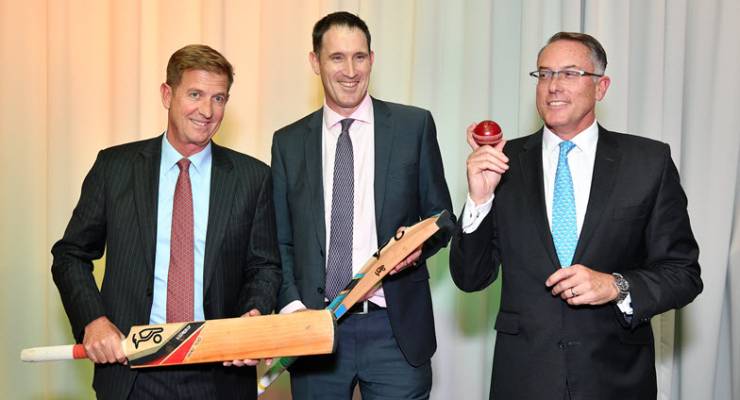
Seven West Media CEO Tim Worner, Cricket Australia CEO James Sutherland, and Fox Sports CEO Patrick Delaney
Shareholders in Seven West Media should enjoy the boost from the new cricket deal while they can, because they may well come to regret undermining the anti-siphoning laws.
It’s over 20 years since Rupert Murdoch told his shareholders at the 1996 News Ltd AGM that sport would the “battering ram” for pay TV to smash the attention monopolies of free-to-air television. The inelegantly named “anti-siphoning” list was meant to restrain that battering ram to ensure that major events “should be made available free to the general public” — in particular to the seven million non-Foxtel households.
Now, Seven has politely run up the portcullis and ushered Foxtel inside the castle, signing up to a Foxtel-Seven-Cricket Australia deal that shifts two of the three forms of international cricket — 50-over ODIs and T20s — from free-to-air to pay. This is despite the fact that the anti-siphoning laws are meant to ensure this would not occur.
It’s short-term gain (for Seven) for probably long-term pain. While the rules were designed to protect consumers, the financial beneficiaries have been the free-to-air networks. They’ve only had to compete with each other for rights, not with Foxtel. And the value of that protection has been built into their share price, until now.
[Is this $1 billion cricket deal all it’s cracked up to be?]
They learnt from the UK and US experience, where the pay networks — particularly Murdoch’s networks — bid record amounts to capture major sports. Even the English Premier League, the most watched sport in the world, is locked behind paywalls in its home country.
Sporting organisations loved it then, just as Cricket Australia loves it now: all that extra cash from a new bidder! But sports watchers don’t, which is why we have anti-siphoning laws in the first place. And that’s why all the players in Friday’s announcement — Seven, Foxtel, CA, even Communications Minister Mitch Fifield — are stressing their deep support for public access.
The design flaw that the deal is exploiting: the anti-siphoning legislation only requires free-to-air television to bid for the rights, which Seven has done as part of the consortium with Foxtel. It doesn’t force them to actually broadcast anything. So Seven, apparently, have decided that they won’t exercise the rights, leaving the way open for Foxtel to have exclusive access.
Perhaps not the spirit of the game, but regulators are only interested in the letter of the law. Fifield has referred to the AFL and NRL where not all games are broadcast free on any weekend. The difference of course is both history and scale. It’s rare that all footy games in either code have been broadcast free to air. ODIs and T20 always have been. And the games that are not broadcast are the less popular ones. Last summer, the ODIs drew about 1.1 million viewers. Last Friday’s Foxtel exclusive Storm v Knights drew 200,000.
Fifield says the matter is up to the Australian Communications and Media Authority (although see point 14 on the Institute of Public Affairs wish list — abolish ACMA!)
Coincidentally, just last week, Fifield beefed up the regulator’s leadership team with a slate of new appointments including new CEO and deputy chair Creina Chapman. Chapman once worked as a lobbyist for Foxtel’s owner, News Ltd, and before that for Nine. At both times, anti-siphoning was a live issue, so she won’t be coming to the issue cold.
Seven will no doubt shrug its shoulders. It’s paying marginally more for the cricket (about $75 million a year) that Nine has agreed to pay for the tennis (about $60 million a year) and getting more television hours out of it. It will think the threat from pay is over-stated.
Foxtel needs this more. That’s why it’s paying the lion’s share of the bill — about $100 million a year. Foxtel is doubling down on sport as its subscriber numbers (currently at about 2.8 million households) slide slowly in the face of streaming services Netflix and Stan. This doesn’t address Foxtel’s big problem: its cost base makes it uncompetitive with streaming.
Assuming the deal adds subscribers at no marginal cost, Foxtel will need about 300,000 more to sign up to its sports package to break even on the deal — a 10% bump. Hmm… courageous.








And what do we the sports ground owners get? SFA.
Might be time for a government looking to win some public favour in the leadup to a federal election, to make an amendment to the anti-siphoning rules REQUIRING the FTA rights-holders to broadcast all international T20 and one-dayers played within Australia, in return for an on-going waiving of their licence fees, or be forced to relinquish those rights to another FTA station. That would put the cat amongst the pigeons and be very popular with the electorate.
and one day cricket, but we won’t be getting Foxtel to watch them. Sooner do without. But what more do you expect from very ordinary folk like Tim Warner and Sutherland?
I thought cricket was kinda toxic, due to recent lachrymosity events.
Oh, that news cycle.
Simple – just go to one of the free cricket streaming sites, they’re not hard to find. Just wield the Willow.